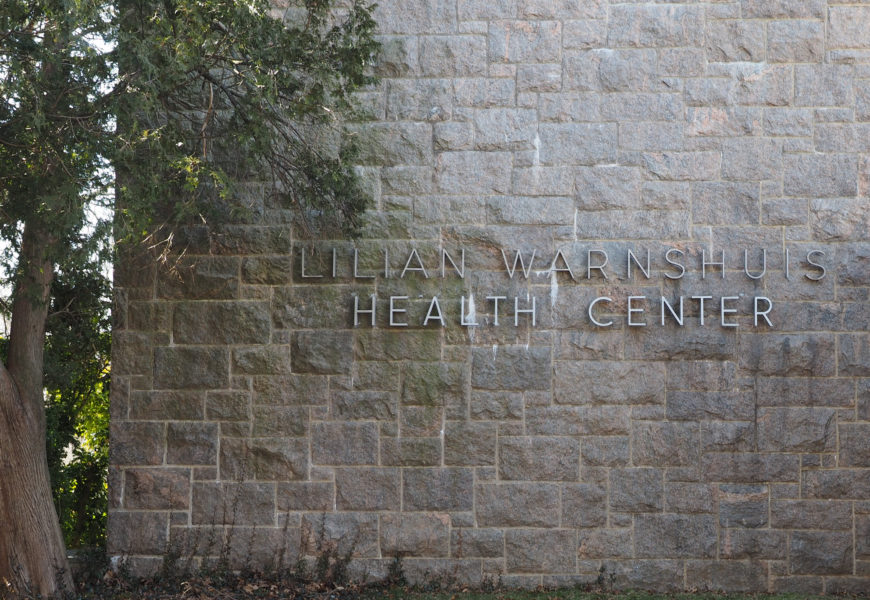The moment that I saw blood streaming down my hand, I knew that a band-aid couldn’t fix it. I furiously wrapped scratchy paper towels around my right hand, and ran out of the bathroom to my room, where I pulled out from under my bed a first aid kit that my mom had gifted me before starting college three years ago. Alas, the sterile pad and flimsy gauze bandage were useless against the half-inch long gash along my right index finger, caused by a chip in the glass coffee pot that I had been cleaning out. For the first time in my college career, I had to go to the Health Center.
I wiggled into my coat and ran out of my dorm with a mummified right hand that I clutched to my chest. After some trouble remembering where the Warshuis Health Center was located, I ran through the empty waiting room to the front desk and asked if someone could help bind my right hand. The practicum student gaped at me, and called to the Administrative Assistant Jill Pilgrim in the adjacent office. Jill explained that there were no nurses, and that she would have to call Campus Safety who would call Uber Health to drive me to Urgent Care.
A combination of sleep-deprivation, stress, and shock made me burst into tears. “I just wanted some coffee,” I cried. Jill offered me a box of tissues.
In a few minutes, a Campus Safety officer wearing a medical mask picked me up. To pass the time until an Uber Health car picked me up in front of Cro, he told me about all the hand wounds he had sustained in culinary school. (I should have asked how he ended up as a security officer at a liberal arts college.) Two hours later, I was being driven back to Conn in an Uber with a purple bandage wrapped around my hand.
I came into the Health Center expecting to meet an on-site nurse, similar to the one I had had in elementary school who would invite me into her office, have me take a seat on the examination table, and send me out with a lollipop in hand. Sending me to Urgent Care felt excessive and stressful at the time, but perhaps it was a better call. (Luckily, I didn’t need stitches.) Then again, I hadn’t thoroughly read one of the many emails from Dean Cardwell on Jan. 24 updating students on the Health Service hours for that week. Medical appointments were only available on Tuesday, Wednesday, and Friday.
Although this was hopefully a one-time experience for me, students use the Health Center’s services on a weekly basis — mostly for mental health. According to the Health Services website page, over 50% of camels use student counseling services. In comparison, only twenty students have used the Uber Health services since January, according to Amanda’s and Margaret’s article on page 6. Although counseling services are available Monday-Friday, a lack of medical care on-campus adds unnecessary stress to students’ busy lives.
With the global fear and precautions toward the recent outbreak of the Coronavirus in December, there is uncertainty about how the College would contain an outbreak if a student developed the seemingly mild symptoms of the coronavirus. Although “there is no immediate threat to the Connecticut College campus community” according to the Student Health Services web page, it has affected study abroad students (including Elizabeth Berry, whose article on page 5) who have been pulled from their programs. Students returning from Iran, China, Italy, and South Korea “which the CDC classifies as a Warning Level 3 will not be allowed to return to campus until they are 14 days without symptoms from the date of arrival in the United States (or the CDC-recommended quarantine period). For anyone traveling from a country that the CDC classifies as Alert Level 2, the College may restrict access to campus for the CDC-recommended period of time,” according to an email sent to the College from the Vice President for Finance and Administration Richard Madonna on Feb. 27.
The U.S. spends the most money on healthcare than any other country in the world, according to Professor of Economics Mónika López-Anuarbe. Her presentation “Beyond the Disarray: Hopeful Healthcare Solutions” at the TEDx conference at Connecticut College on Saturday Feb. 29 highlighted both refugees and American citizens’ lack of access to equitable health care.
The confusion and vulnerability that I had felt sitting in the Health Center are not unlike what society feels about the coronavirus. If anything, moments like these are reminders that care should be made universal and accessible. One doesn’t think that they need treatment until they need it. •
Photo courtesy of Sophia Angele-Kuehn










